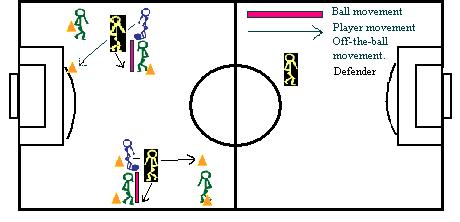Teaching Points:
-
Similar to previous grid game, but to add tactical complexity, the teacher
adds a defender. Forces students to problem solve and make better decisions.
-
To understand the value and use of support.
-
Always be moving, looking for open spaces to help support others.
-
Receive the pass on the run. Important to have control of the ball before
exercising a pass. Absorb the ball with foot. Do this by cradling the ball
as it approaches the foot.
-
Make easy passes, preferably a straight line.
-
Defending space. Must defend ball carrier.
-
Defender may also use fakes to apply pressure onto ball carrier to make
a inaccurate passes.
-
Begin game with the defender using a walking pace. As students succeed
in completions, then allow the defender to attack at regular pace.
|

| Similar to previous activity, but now to add tactical complexity, a
defender is added. Without a defender the students got used to the movement
involved. With a defender, problem solving and decision making comes into
effect. Defender must attack ball carrier. Encourage defender to begin
at a walking pace, then increase speed. |
|
Organizational Points:
-
Use of 4 students only in this game. One can get a ball, while the other
set up. A teacher can use 5 students in this game if one agrees to be a
coach.
-
If a student coach is implemented, then rotate positions after a certain
amount of time or completions.
-
As students begin to understand the tactics of this game, introduce new
rules. If defender is having difficulties, then make a rule where the offense
can only pass on straight lines not angles.
-
If offense is having difficulties, then allow the students to call out
names of the students who are intended to receive a pass or locate to another
space.
-
For an uncompromising rotation technique, allow rotation when the defender
intercepts or regains possession of the ball. The student who made the
turn over must become the defender and the previous defender assumes his/her
position in the grid.
|
 |
Grid
Passing and Defending
Game/Task
Outline
Grid
Passing and Defending
Game/Task
Outline